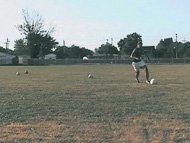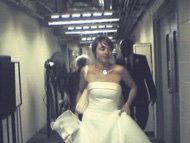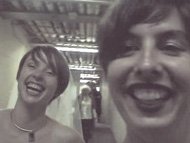Framing Your Shots
| Framing is what you do when you zoom in or adjust the camera's position to select the size and placement of your subject within the viewfinder. You probably have an intuitive sense of how framing works from watching TV and movies, and you may be familiar with basic shots. But since your video is destined for the Web rather than Hollywood, let's review framing and shots with a videoblog in mind. You can move closer or farther from your subject in two ways: by zooming in and out with the camera lens, and by physically moving the camera. These two methods produce slightly different results. The close-up shown in Figure 4.10 was shot at a distance by zooming in on the subject. The close-up in Figure 4.11 was shot with the camera at arm's length from the subject. Notice how the background in the first close-up is out of focus, while the background in the second is in focus. Both close ups keep our attention where the vlogger wants it, on the subjects being taped. Figure 4.10. In this close up from "Segue (Hiatus)," a video from his Taxiplasm Vlog about high school graduation, Brian Gonzalez zooms in from a distance to blur the background and focus our attention on a friend. http://guitseretni.blogspot.com/2005/06/segue-hiatus.html Figure 4.11. In this close-up from Chris Weagel's "LAC St. Clair" from the Human Dog Laboratory vlog, the camera is zoomed out but close to the subject's face, which keeps the background in focus. www.human-dog.com/lab/?p=62 The opposite of the close-up is the wide shot. Use wide shots to establish the location of your subject, capture a lot of action, or follow someone moving quickly. To shoot a true wide shot, you need to both position your camera far from the subject or scene and zoom out. In Figure 4.12, Sara Weagel uses a wide shot to establish that she's practicing alone on a soccer field Figure 4.12. In this wide shot, the viewer can see Sara Weagel alone on the field as she practices her game in "Oh Boy, Soccer!" from her vlog, Sara's Corner. www.human-dog.com/sara/?p=17 In a videoblog, wide shots like Sara's are best used for only a few seconds at a time. That's because once the video is resized for the Web, a distant figure will be extremely small and hard to see. Longer wide shots can work on the Web if whatever fills the frame is the main attraction. The mountain scene shot during Josh Leo's hike in Germany is a good example (Figure 4.13). Figure 4.13. In "German Hiking Part 2," from Josh Leo's Vlog, Josh uses a wide shot to show us the view while hiking in the Bavarian Alps. http://joshleo.blogspot.com/2005/11/german-hiking-part-2.html In the medium shot, your subject is still prominent but viewers can also see where the action is taking place or what's around your subject. In Figure 4.14, Charlene Rule uses a medium shot to show us the excitement of a friend just moments before she is married, and the rush of activity around her. Figure 4.14. In "Vero Strut" from Charlene Rule's vlog Scratch Video, Charlene films her friend strutting down a back hallway on her way to the altar. In the same video, Charlene uses a two-shot to capture a moment she shared with a friend (Figure 4.15). Figure 4.15. A few seconds later Charlene and her friend share a laugh. Some vloggers use a variety of shots within a single video, while others just use one or two. Television and film have stylistic rules about which shot to use when, but as a vlogger you have a slightly different set of visual concernsnamely the small viewing size and short length of your video. So before you start recording, ask yourself how you can frame your scenes so they translate effectively onto the (really) small screen. |
EAN: 2147483647
Pages: 81





